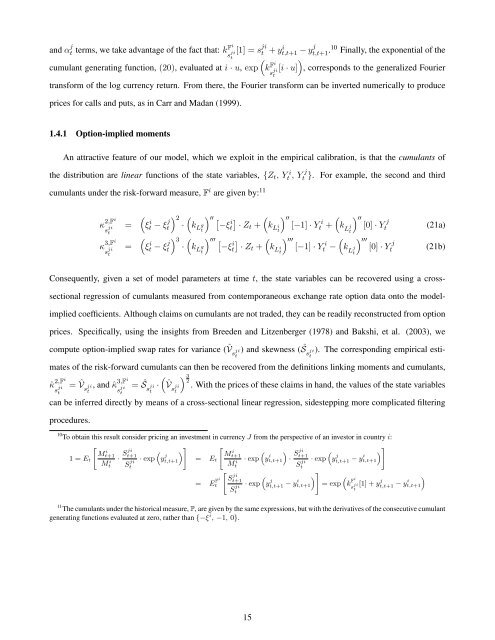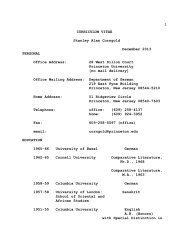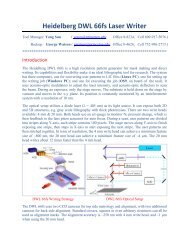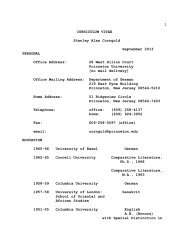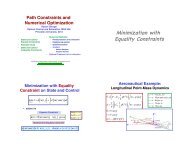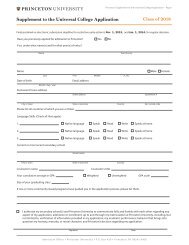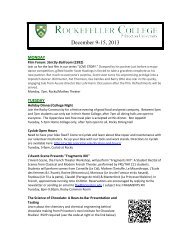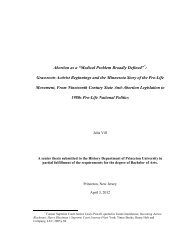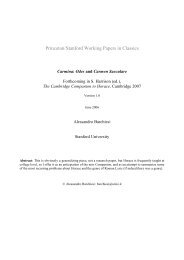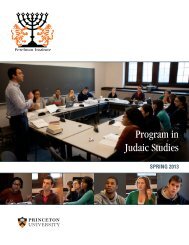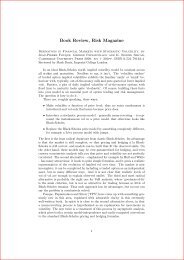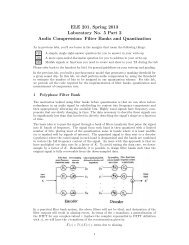Option-Implied Currency Risk Premia - Princeton University
Option-Implied Currency Risk Premia - Princeton University
Option-Implied Currency Risk Premia - Princeton University
Create successful ePaper yourself
Turn your PDF publications into a flip-book with our unique Google optimized e-Paper software.
and α j t terms, we take advantage of the fact that: kFi [1] = s ji<br />
s ji t + yt,t+1 i − yj t,t+1 .10 Finally, the exponential of the<br />
t ( )<br />
cumulant generating function, (20), evaluated at i · u, exp k Fi [i · u] , corresponds to the generalized Fourier<br />
transform of the log currency return. From there, the Fourier transform can be inverted numerically to produce<br />
prices for calls and puts, as in Carr and Madan (1999).<br />
s ji<br />
t<br />
1.4.1 <strong>Option</strong>-implied moments<br />
An attractive feature of our model, which we exploit in the empirical calibration, is that the cumulants of<br />
the distribution are linear functions of the state variables, {Z t , Yt i , Y j }. For example, the second and third<br />
cumulants under the risk-forward measure, F i are given by: 11<br />
t<br />
κ 2,Fi<br />
s ji<br />
t<br />
κ 3,Fi<br />
s ji<br />
t<br />
=<br />
=<br />
( ) 2 (<br />
ξt i − ξ j t ·<br />
( ) 3 (<br />
ξt i − ξ j t ·<br />
k L<br />
g<br />
t<br />
k L<br />
g<br />
t<br />
) ′′ [−ξ ] ( ) ′′<br />
i<br />
t · Zt + k L i<br />
t<br />
[−1] · Y<br />
i<br />
t +<br />
) ′′′ [−ξ ] ( ) ′′′<br />
i<br />
t · Zt + k L i<br />
t<br />
[−1] · Y<br />
i<br />
t −<br />
(<br />
k L<br />
j<br />
t<br />
(<br />
k L<br />
j<br />
t<br />
) ′′<br />
[0] · Y<br />
j<br />
t<br />
) ′′′<br />
[0] · Y<br />
j<br />
t<br />
(21a)<br />
(21b)<br />
Consequently, given a set of model parameters at time t, the state variables can be recovered using a crosssectional<br />
regression of cumulants measured from contemporaneous exchange rate option data onto the modelimplied<br />
coefficients. Although claims on cumulants are not traded, they can be readily reconstructed from option<br />
prices. Specifically, using the insights from Breeden and Litzenberger (1978) and Bakshi, et al. (2003), we<br />
compute option-implied swap rates for variance ( ˆV s<br />
ji<br />
t<br />
) and skewness (Ŝs ji ). The corresponding empirical esti-<br />
t<br />
mates of the risk-forward cumulants can then be recovered from the definitions linking moments and cumulants,<br />
ˆκ 2,Fi = ˆV<br />
( ) 3<br />
s ji s<br />
ji, and ˆκ 3,Fi<br />
2<br />
=<br />
t<br />
t s ji Ŝsji<br />
· ˆVs ji . With the prices of these claims in hand, the values of the state variables<br />
t<br />
t t<br />
can be inferred directly by means of a cross-sectional linear regression, sidestepping more complicated filtering<br />
procedures.<br />
10 To obtain this result consider pricing an investment in currency J from the perspective of an investor in country i:<br />
[<br />
M i ( ) ] [<br />
t+1<br />
1 = E t · Sji t+1<br />
· exp y j M i ( )<br />
(<br />
) ]<br />
t+1<br />
Mt<br />
i S ji<br />
t,t+1 = E t · exp y i<br />
M i t,t+1 · Sji t+1<br />
· exp y j<br />
t<br />
t<br />
S ji<br />
t,t+1 − yt,t+1<br />
i<br />
t<br />
= E Fi<br />
t<br />
[<br />
S<br />
ji (<br />
t+1<br />
· exp y j<br />
S ji<br />
t,t+1 − yt,t+1) ]<br />
i = exp<br />
t<br />
(k Fi<br />
s ji<br />
t<br />
[1] + y j t,t+1 − y i t,t+1<br />
11 The cumulants under the historical measure, P, are given by the same expressions, but with the derivatives of the consecutive cumulant<br />
generating functions evaluated at zero, rather than {−ξ i , −1, 0}.<br />
)<br />
15


